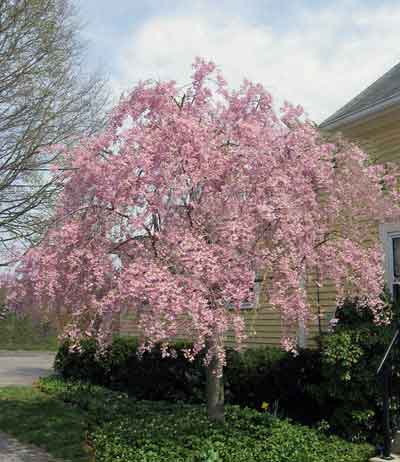Arboriculture (Tree Care)

Trees provide architectural scale, shade, beauty and value to any property. Correct care is required from initial planting and throughout the life cycle of the tree to keep it a great investment for years to come. Care includes correct planting methods; pruning methods, insect/disease diagnosis and management, deep root fertilization, cabling, soil analysis, and root collar excavation. Only a certified arborist can identify and address these concerns. During our initial site analysis and consultation, I will identify the tree and its needs by looking at the soil, the structure, the flare and the foliage. My one-on-one tree care instructions (for things like correct planting and pruning) will give you enough knowledge to keep your trees looking healthy and beautiful for years to come.
I am always available for follow up visits.
Below is a list of the arboriculture services and knowledge I can provide for you:
Correct planting The proper depth at which a tree is planted is very important for its health and longevity. Planting too deep and over mulching can lead to slow growth and tree decline. At this point, watering and fertilization is of no use. If caught early enough, a tree may be replanted at the correct depth and given a better chance to thrive.
Ornamental pruning Each ornamental tree needs to be treated as an individual. Tree care should be tailored according to each tree's unique species, size and environment. With proper pruning, light will dapple through and animals will gravitate to a healthy tree. Neglect or poor pruning techniques require additional attention; structural and corrective pruning will need to be done.
Shade tree pruning All types of trees need to be pruned, both for aesthetic and safety reasons. For shade trees, crown reduction is an important step after an ice storm. Crown thinning or raising may be a solution to allow more light into the lawn and shrubs below. Structural pruning includes safely removing damaged branches overhanging a house.
Insect and disease diagnosis/ management Premature death of a tree can happen unless there is a quick assessment and treatment of the cause. Insects can destroy your trees and garden in a matter of days. Some known parasites include: winter moths, Asian longhorn beetles, wooly adelgids, aphids, mites and scales. Diseases, due to cultural or environmental stresses, can weaken or kill trees. Trees have the ability to fight off some unwanted pathogens in an ideal environment. If you help the environment, you help the tree. Sprays are used when necessary. Monitoring and care is crucial.
Soil analysis A soil test gives information on whether a tree's nutritional needs are met. Each tree's needs differ. Many trees are imported. Soil requirements differ. The more suitable is soil is for each individual tree, the healthier it is.
Fertilization A balanced fertilization program is the cornerstone of tree health. This is usually done in the spring and fall. It helps to correct and prevent nutrient deficiencies all year round. Fall fertilization helps sustain a tree during its winter dormancy, and spring fertilization helps during a summer draught.
Soil Conditioning Most soils consists of a sandy or clay type loam which lack organic matter. The right blend of sand, clay and organic matter, spread along the root zone, can make all the difference in tree's health and growth. Soil conditioning also encourages strong feeding roots with other vegetation such as lawns and gardens.
Water Management Trees may not show symptoms of inappropriate water levels for years. Too much water or not enough water will lead to an increase in insect and disease activity. Most of the symptoms above the ground start in the roots below the ground. In addition, inappropriate water management affects newly planted trees, as well. Proper water management aids in the health or the tree by prevent insects and disease. It can be done by hand or irrigation methods.
Mulching Proper mulching benefits a tree in many ways. It reduces evaporation of water and weed growth. It helps prevent injury to stems on young trees. It can prevent soil compaction leading to properly drained water. When the mulch starts to decompose, it adds nutrients to the soil. Over-mulching or "volcano" mulching is detrimental to trees and shrubs, since it can lead to oxygen deprivation and root girdling, and allows for disease -causing pathogens to enter the tree. Mulch, spread away from the base of the tree, at between 2-4 inches in depth, allows for easy maintenance, esthetics, and overall health of the tree.
Cabling Some trees need extra structural support when a defect is found. Overhanging limbs above a roof line, parking area, or pool can create a hazardous area. Heavy weak limbs and deep crotches weaken a tree and put it at risk for failure. Cabling will add strength, safety and longevity.
Root collar excavation exposes the flare at the trunk of the tree by removing the soil by hand or using an air compressor. This process establishes proper grades and airflow around the root zone. Root collar excavation exposes root girdling and reverses soil compaction. Root girdling becomes necessary when the tree's own roots choke itself. Soil decompaction allows air, water and fertilizer to reach the roots.
Preconstruction Plan Development and Management Before you build on a new site, add an addition to your house or perform any kind of construction on your property, plan to prevent construction damage to valuable and irreplaceable trees and vegetation. Construction too close to trees will leave behind root and bark damage, soil compaction, erosion, and grade changes that negatively affect the tree. The tree may appear healthy but in the following years will decline rapidly. A certified arborist, on hand during the construction phase, is very important. He may make suggestions like fencing, temporary mulching, pruning or transplanting to save valuable trees and vegetation.

Bringing together...
Horticulture, Arboriculture & Landscape Design
